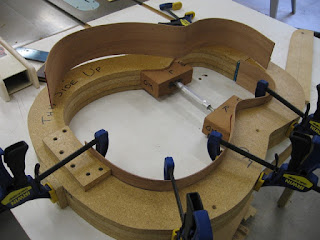






Day 1: Top, Back and Sides
The traditional wood for the soundboard is sitka spruce, chosen for its straight, even grain and high strength to weight ratio. It will have to withstand over 100 lbs of pull when the strings are brought up to pitch. The top is thus in a fairly highly stressed state and sensitive to the vibrations of the strings. When finished it will be a little over one tenth of an inch thick with some thin braces or ribs on the back to add strength. This is the main source of the guitar's sound. A heavy top will be unresponsive and the guitar won't have good tone. Too flimsy a top will not withstand the stress of the strings and may warp or collapse. Manufactured guitars tend to be heavily built to withstand the wide range of humidity and general treatment to which they will be subjected.
The back and sides are generally made of a denser wood such as mahogany or rosewood. The role here is to support the soundboard and to resonate as it vibrates and amplify and reflect the sound through the soundhole.
Chuck has a good stash of mahogany and had sawn some to starting thickness for me to choose from. The individual boards are 'book sawn' in pairs such that when glued together along the long edge, the grain on one side should be a mirror image of that on the other. I chose a pair with an unusual band of darker grain running through it which caught my eye. The sides are similarly book sawn. The pair I chose had a nice upward sweep to the grain which should add visual interest to the end of the soundbox.
There are various ways to bend the sides. Chuck, being the engineer that he is, has come up with a very clever device. One side at a time is dampened then placed in the center of a five part sandwich with a layer of spring steel and a thermal blanket on each side. The layers are then placed in a jig, power turned on and when the water in the wood turns to steam, the sides can be bent and clamped to the jig without breaking. After a little more cooking they are allowed to cool and when removed they hold their shape.
The book sawn pairs for the back and top are glued along their long edge and then cut to shape and sanded to the desired thickness. Chuck helped me judge the end point by holding the board between finger and thumb, tapping it with a knuckle and listening to the resonance. It gets brighter as it gets thinner but there is a point of no return beyond which it won't be able to support the tension of the strings. I stopped sanding at around o.120 ". Once glued to the top of the guitar it will be thinned a little more around the edges of the lower bout which will allow it to vibrate more freely, rather like the cone of a speaker with its flexible surround.
The shaped sides are clamped into another jig and the end blocks are glued in place. We now have the main components of the sound box, ready for bracing and assembly tomorrow.


This is great dad. Sounds like a very precise process!
ReplyDeleteJake is a master musician and master engineer. This should end up being a highly engineered musical instrument!! I also can appreciate his infatuation with the wood. I've always been a woodie guy myself. It makes the best guitars (why would you play a fiberglass sting holder?), ... and the best cars.
ReplyDelete